Porcelain Insulator News
by Elton Gish
Reprinted from "Crown Jewels of the Wire", May 1996, page 5
We first reported M-2495 in November 1995. This odd, long-skirted multipart
is the cousin to M-2395. I am not sure of the manufacturer of M-2395, but Thomas
made the M-2495. The square-edged crown and “blue-jean seams” inside the
bottom skirt are very characteristic. Soon after reading the November 1995 PIN
article, Donald Myers (Avilla, IN) sent me several photographs of a M-2495 which
he bought a number of years ago at a small antique show in Fort Wayne, IN.
Donald’s insulator makes two known. The glaze color is a rich rusty brown and
somewhat lighter in color than my specimen. When Donald showed his insulator a
few years ago at a local show, he, too, got comments from collectors who thought
it was a fake.

M-2395
(7.5 - 6 x 11)
|

M-2495
(8 - 6 x 10)
|
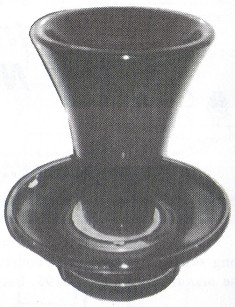
Underside view of Donald's M-2495.
|
The very long skirt does make the insulator look out of the
ordinary; however, the cement joint is original. No doubt this type of insulator
had trouble staying on the pin when the slightest horizontal strain was
experienced on the conductor. Fortunately, two fine specimens have survived. Ken
Stefan just sent me the photograph below which clearly shows the profile of his
M-2395 (only one known). Note the different crown which suggests that Thomas was
not the manufacturer.
It would not surprise me to eventually learn that M-2395 was a Fred Locke
design and perhaps Thomas copied it for their M-2495. Note the similarity of
M-2395 to his patent No. 822,211 (5-29-1906) [Patent drawing from Fred M. Locke:
A Biography. It was digitally scanned and enhanced by Bill Meier]. The bottom
flare is exaggerated and no one would ever put threads just in the bottom half.
Fred Locke’s patent claimed the “bell-shaped porcelain center piece” and
the flat top (at a’ on drawing) of the bottom skirt which is “parallel with
its lower end face”. I can’t imagine what purpose the flat surface in the
cement joint could have served. The patent described the top skirt as a “porcelain
cap” which is exactly what it looks like on the oversized bottom skirt. The
intention of the patent was “to construct an insulator in such a way as to
increase the arcing distance and insulating area between the conducting wire and
the pin, thereby preventing the arcing of the current and burning of the pin”.
This patent was probably a clever attempt by Fred Locke to copy C. C. Chesney’s
patent (No. 761,760 granted on 6-7-1904) for the lily-shell multipart insulator
design similar to M-3740 (see patent drawing in my book, Multipart Porcelain
Insulators).
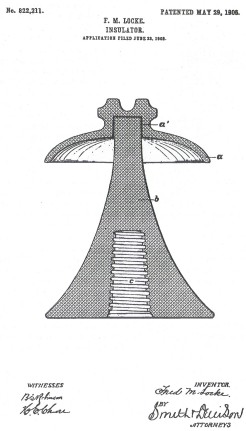
Medium Image (62 Kb)
Large Image (146 Kb)
Gary Scott (NIA #5758) sent me some nice photographs he took of his
collection with a Kodak panoramic camera. Several of his photos look like the
insulators were sitting in front of a mural of a snow-covered country scene, but
it was just Gary’s back yard. Something East Texas natives rarely see. Gary
reported having several M-2224 insulators with the incuse COOK marking. The
downward slant to the top conductor groove is characteristic of many Cook
insulator styles. This feature was claimed in W. S. Cook’s patent No.
1,688,411 (10-23-1928- see patent drawing in, Multipart Porcelain
Insulators).
Gary said that he found the four M-2224’s around 1975 on an old transmission
line (23 Kv) that had been downgraded to distribution service. He had to wade
through a swampy area after the poles were downed by a windstorm to get them.
The insulators survived because they were not replaced when the line was
re-insulated for the lower voltage service. The linemen probably didn’t want
to get their feet wet. Only one M-2224 Cook was reported in the Value
Guide.
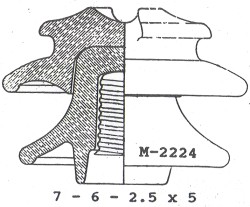
Dennis Stewart (Cincinnati, OH) contacted me recently about a porcelain
collection that he and his father started putting together about 30 years ago.
Most of it had been boxed up for the past 20 years and now Dennis is excited at
renewing his interest in porcelain. He has a certain fondness for multipart
porcelain. Unfortunately, I missed meeting him on Sunday at the London show last
November. You would be surprised at what this collection has to offer. Dennis
sent a few photographs then decided to produce an 8-minute video so I could get
a better look at what some of the first boxes had in them. The video is
professional in every way from beginning title, credits, interesting background
music, and creative photography. Only two specimens of M-2332 have been reported
and just one of those has Fred Locke incuse marking #6-1. Dennis has a beautiful
M-2332 with light tan bottom skirt and a 6-date marking! The photo shown here of
M-2332 is the unmarked specimen owned by Bill Rohde (NIA #1219). The top skirt
is a rich dark tan color and the short bottom skirt is a very light tan! The
Greater Chicago Insulator Club has recently found pieces of M-2332 along a line
near Chicago. Another rare insulator in Dennis’ collection is a gray M-4395
with large embossed O-B marking on the side of the cross-top. He also has two
M-2636’s, one unmarked and one with the embossed O-B marking. Both insulators
have a 1/2 inch tall block letter “E” under the top skirt. We knew Ohio
Brass cataloged M-2636, but Dennis is the first person to report one. Dennis has
another unique M-2636 with the incuse marking, JOHNS-MANVILLE!! This is the
first report, too, of this marking/style combination. Multipart Johns-Manville
insulators were made by the New Lexington High Voltage Porcelain Co.
(1903-1912). Now that Dennis is acquiring the entire collection and bringing it
into his home, he says he is flirting with A.I.D.S. (Acquired Insulator
Divorce Syndrome). One classic symptom is sneaking a multipart insulator into the house
while your wife is taking a bath or otherwise distracted, hoping that she will
not notice the new “boat anchor” which is too pretty and valuable to let
gather dust in the garage. Unfortunately, Dennis, many of us have that problem,
too. There is no known cure.
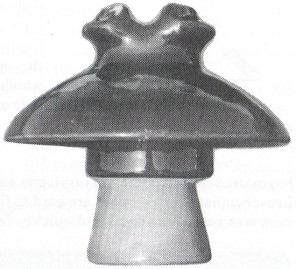
M-2332 made by Fred Locke.
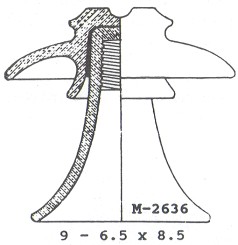
One go-with we have never discussed in PIN are wooden boxes used to ship
porcelain insulators and pole line hardware. I suspect that wooden boxes are
hard to find since their usefulness was very short lived and quickly found their
way in the dump or burned for warmth at line construction camps. Jeffrey Hollis
(Martinsburg, WV) sent photographs of a wooden box imprinted with “Locke
Insulator Corp., Pole Line Hardware, Manufactured Exclusively by Seyler Mfg.
Co., Pittsburgh, PA”. Another marking contained numbers which indicate that
the box originally contained 25 forged steel pins with lead heads (threads) that
were designed to be mounted on wooden crossarms. Seyler was a manufacturer of
pole line hardware and carried a line of Locke insulators in their catalogs. The
name Locke Insulator Corp. was used from 1921 to 1948. The box, which was made
of thin wooden planks and reinforced with wire, was probably made in the 1940’s.
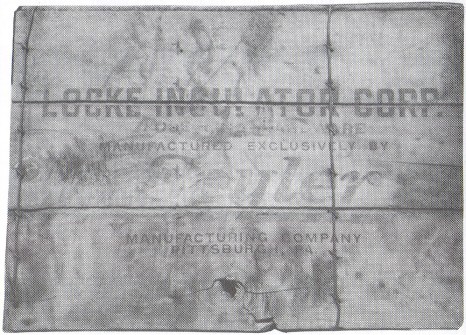
Wooden box for Seyler steel pins sold by Locke.
After the Marlborough National last July, we traveled through New England. I
found a wooden box from the Joslyn company at an antique store in Maine for $2.
The marking on the end of the box indicated that it contained 50 steel pins. The
Joslyn Mfg. & Supply Co. was formed in about 1902 and was a leading supplier
of pole line equipment as late as the 1960’s. I don’t know what happened to
the company after that. The company’s founder, M. L. Joslyn, was a major
stockholder in the Porcelain Insulator Corp. (PINCO) when that company was
formed in 1920 by William Harvey and others. Pinco insulators were sold
primarily through Joslyn for many years. Joslyn also carried a line of porcelain
insulators made by Illinois Electric Porcelain Co. and Hemingray glass
insulators during the 1930’s and 1940’s. After I bought the well preserved
box, I had about a week to devise a plan to get it on the airplane for the trip
home as part of my carry-on luggage. It turned out to be a great way to
transport a couple of rare insulators picked up at the National along with
another breakable item.
At the National show, I got a small wooden board that was imprinted “Locke
Insulator Corp. Baltimore, Maryland." As stated above, Locke used that name from
1921-1948, so that helps to date the board. I would guess it was made in the
1940’s. These are just a few wooden box go-withs that I know about. Some of
you may have other items that help to add interest to your porcelain insulator
collection.
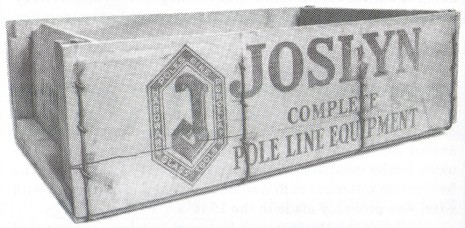
Wooden box for Joslyn steel pins.
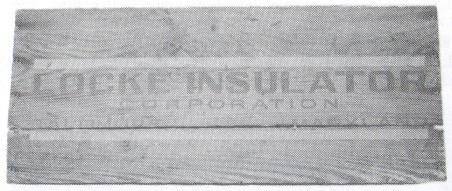
Board from Locke Insulator Corp. wooden box.
| 